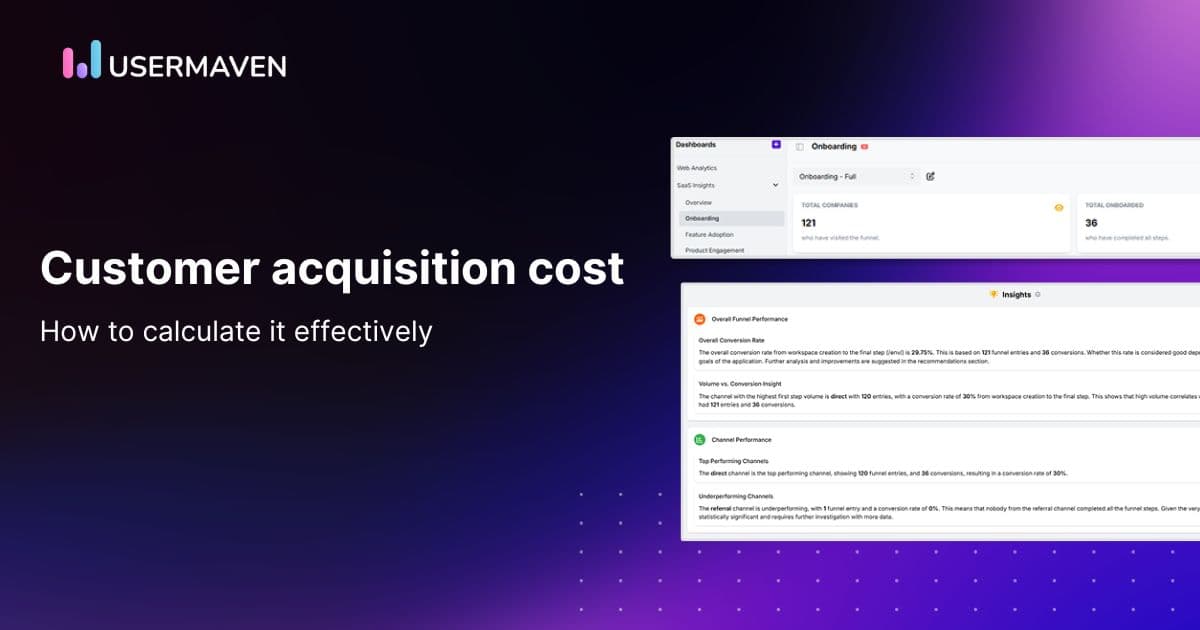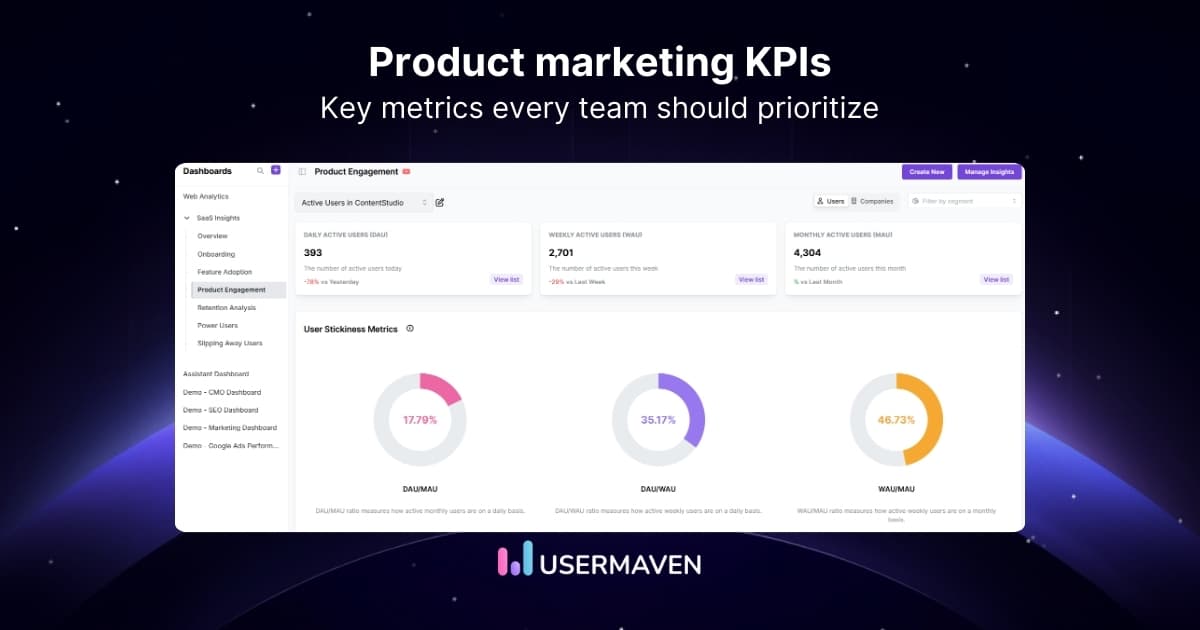Table of contents
How to calculate customer acquisition cost (CAC) effectively
May 22, 2025
5 mins read
Written by Ameena Hassan

Understanding how to calculate customer acquisition cost (CAC) is one of the most important steps in building a sustainable business. CAC tells you exactly how much you’re spending to turn a prospect into a paying customer, factoring in everything from ad spending and sales commissions to tools and team salaries.
Why does this matter? Because if you’re spending more to acquire customers than they’re worth over time, you’re not growing; you’re losing money. Knowing your CAC helps you measure marketing efficiency, optimize your budget, and make informed decisions about where to invest next.
In this guide, we’ll explain what CAC really means, how it differs from CPA, what costs to include, how to calculate it step by step, and how tools like Usermaven can simplify the process.
What is customer acquisition cost (CAC)?
Customer acquisition cost (CAC) refers to the total expense a business incurs to acquire a single paying customer. This includes all costs related to sales and marketing efforts over a defined period, such as ad spend, employee salaries, software tools, and creative production, divided by the number of new customers gained during that same period.
In simple terms:
CAC = Total sales & marketing costs ÷ Number of new customers acquired
For example, if your company spent $50,000 on marketing and sales in a month and acquired 250 new customers, your CAC would be $200.
Why does this matter?
Understanding how to calculate customer acquisition cost helps you see beyond the number, it reveals how efficiently you’re converting interest into revenue. If your CAC is high, you’re spending too much to acquire each customer; if it’s low, your acquisition strategies are more cost-effective.
Understanding CAC helps you answer critical business questions:
- Are you spending your budget wisely?
- Are your marketing channels delivering a strong ROI?
- Is your business set up for sustainable growth?
By monitoring CAC over time, you can spot trends, identify inefficiencies, and continuously optimize your acquisition efforts.
What is the difference between CPA and CAC?

CPA (Cost per acquisition) and CAC (Customer acquisition cost) are both metrics used to measure marketing effectiveness, but they serve different purposes and scopes.
Cost per acquisition (CPA) measures the cost to acquire a specific conversion action, such as a sign-up, download, or trial, not necessarily a paying customer. It’s commonly used in performance marketing to track campaign-level efficiency.
CAC, however, takes a broader approach by reflecting the total cost of acquiring a paying customer. Understanding how to calculate customer acquisition cost involves including all sales and marketing expenses, giving a full picture of what it costs to turn a lead into a loyal customer.
Here’s a comparison to make the distinction clear:
| Aspect | CPA (Cost per acquisition) | CAC (Customer acquisition cost) |
| Definition | Cost to acquire a specific action (e.g. lead, sign-up) | Total cost to acquire a paying customer |
| Focus | Conversion actions | Paying customers |
| Used in | Campaign or channel performance | Business-level financial analysis |
| Formula | Total campaign cost ÷ Number of conversions | Total acquisition cost ÷ Number of new customers |
| Includes | Only campaign cost | Ad spend, tools, salaries, overhead, etc. |
| Goal | Optimize for lower conversion cost | Optimize for sustainable customer acquisition |
| Conversion stage | Top or middle of the funnel | Bottom of the funnel |
In short, CPA is a tactical metric, ideal for optimizing individual campaigns, while CAC is strategic, helping you assess the overall health and profitability of your customer acquisition efforts.
How to calculate customer acquisition cost (CAC)
The basic CAC formula
Here’s the core CAC formula:
CAC = Total sales and marketing costs / Number of new customers acquired
This gives you the average cost of acquiring one paying customer.
For companies with complex marketing funnels, you may need to account for:
- Indirect costs
- Shared expenses
- Multi-channel attribution
Tools like Usermaven streamline this process by automatically aggregating your data, ensuring that nothing is missed.
Does your analytics setup capture all the expenses that should be included in CAC?
Step-by-step calculation process
To calculate CAC accurately:
- Choose a time period that reflects your sales cycle.
- Collect all sales and marketing expenses during that period.
- Sum up these costs.
- Count the number of new paying customers during the same period.
- Divide total costs by total new customers.
Businesses often struggle to gather this data across tools. An integrated platform like Usermaven can unify and track it automatically.
Power up your SaaS
with perfect product analytics
*No credit card required
What costs to include in CAC
Your CAC calculation should account for all costs directly or indirectly tied to acquiring customers:
- Sales and marketing salaries and commissions
- Advertising (Google Ads, Meta, influencers, etc.)
- Creative and content production
- Events and sponsorships
- Tools and software (CRM, analytics, automation)
- Overhead (shared office, utilities, etc.)
Missing any of these leads to underestimating CAC, and overestimating profitability.
Usermaven ensures accurate, real-time expense tracking, so you always know your true acquisition costs.
Analyzing CAC in relation to Lifetime Value (LTV)
Spending to acquire a customer is only worth it if they stick around. That’s where LTV comes in, a key metric to balance against CAC.
What is lifetime value (LTV)?
Lifetime value (LTV) represents the total revenue a customer generates throughout their entire relationship with your business.
It includes:
- Subscription payments
- Upsells and cross-sells
- Repeat purchases
When you compare LTV to CAC, you can tell whether your acquisition efforts are profitable.
If your LTV is much higher than your CAC, your model is likely sustainable. If not, it’s time to re-evaluate.
Understanding the LTV/CAC ratio
This ratio is a key health indicator. A good benchmark is:
LTV/CAC ratio of 3:1, meaning you earn $3 for every $1 spent to acquire a customer.
A poor ratio (1:1 or lower) suggests your business is burning money instead of growing it.
This metric shapes decisions around:
- Marketing spend
- Pricing
- Retention strategies
- Channel performance
Usermaven helps track LTV and CAC together by tying behavior and revenue data to acquisition sources. That’s essential for knowing what’s working; and what’s wasting your budget.
| Business Type | Ideal LTV/CAC Ratio | Notes |
| SaaS | 3:1 | Healthy growth model |
| Subscription | 3:1 | Common benchmark |
| Other | Varies | Industry-specific |
How to reduce customer acquisition cost (CAC)
Cutting CAC isn’t magic; it’s a method. To bring down your customer acquisition cost, you need a clearer view of what’s working, what’s wasteful, and where prospects fall through the cracks. Here’s how to reduce CAC without compromising on quality:
1. Optimize your funnel
Map the full customer journey and identify where prospects drop off. Common improvements include:
- Refining ad targeting
- A/B testing landing pages
- Improving user experience
Usermaven provides funnel analysis to show exactly where leads lose interest, helping you fix leaks and boost conversion rates.

2. Use automation and analytics
Automation tools save time. Analytics tools save money. Combined, they lower CAC.
Use marketing automation for:
- Lead scoring
- Nurture emails
- Retargeting sequences
Use analytics for:
- Real-time insights
- Behavioral tracking
- Channel ROI measurement
Usermaven offers both, letting you spot inefficiencies and double down on what works.
3. Focus on high-value customers
Not all customers are equal. The most valuable ones often cost less to retain and bring in more revenue.
Here’s how to target them:
- Analyze existing customers by LTV
- Find common traits (industry, source, behavior)
- Focus acquisition on similar profiles
- Prioritize channels that bring high-LTV leads
Usermaven’s Attribution and audience insights make it easy to identify these segments and acquire more like them.

Less waste, better targeting, and smarter insights are how you lower CAC and scale sustainably.
Common challenges in calculating CAC

CAC sounds simple on paper, but in practice, it’s easy to get wrong. Inaccurate inputs and misaligned timelines often lead to misleading numbers that can steer your strategy off course.
Here are two common challenges to watch out for; and how to fix them.
1. Data fragmentation and attribution
CAC can be inaccurate if your costs and conversion data are scattered across disconnected tools. This fragmentation leads to misattribution, duplicated efforts, and poor decision-making.
Usermaven solves this with automatic event tracking and unified reporting, so your CAC reflects reality, not guesswork.
2. Timing mismatches with long sales cycles
If your sales cycle stretches over weeks or months, your spending and acquisition events might land in different timeframes. For example, you may invest in ads today but see conversions weeks later. Without aligning spend and outcomes by cohort, your CAC will be skewed.
Usermaven enables time-based cohort analysis, helping you connect the dots and forecast accurately, even with long or complex sales cycles.
3. Inconsistent cost allocation across departments
Marketing, sales, customer success, and even product teams can all contribute to acquiring a customer. If costs aren’t consistently or accurately allocated, especially shared costs like tools, salaries, or content creation, it becomes difficult to get a true picture of CAC. This often leads to either underestimating or overestimating the actual cost.
Accurate CAC starts with accurate data. With unified tracking and time-aligned analysis, Usermaven helps you calculate CAC the right way; and make smarter decisions from it.
Conclusion
Understanding how to calculate customer acquisition cost helps build a profitable business. Use tools like Usermaven to track and optimize CAC easily.
When paired with lifetime value, it becomes a powerful decision-making tool for evaluating strategies and scaling growth.
Using tools like Usermaven, you can automate tracking, reduce manual effort, and improve accuracy. The result: clear insights, smarter decisions, and more efficient growth.
Start calculating your CAC today, and make every marketing dollar count.
Maximize your ROI
with accurate attribution
*No credit card required
FAQs
1. What expenses should I include in CAC?
Include ad spend, salaries of sales and marketing teams, tools, content production, and agency fees.
2. Should I calculate CAC monthly or annually?
It depends on your sales cycle, but monthly or quarterly calculations help you stay agile and data-driven.
3. Is CAC different from CPA (cost per acquisition)?
Yes, CAC includes all costs to acquire a paying customer, while CPA often refers only to the cost of getting a lead or sign-up.
4. Why is calculating CAC important?
Knowing your CAC helps you measure profitability, budget efficiently, and optimize acquisition strategies.
5. What tools help calculate customer acquisition costs?
Analytics platforms like Usermaven simplify CAC tracking with real-time data, attribution, and cohort analysis.
6. Can I calculate CAC by channel?
Yes, and you should. Channel-specific CAC shows which marketing efforts are most cost-effective.
Try for free
Grow your business faster with:
- AI-powered analytics & attribution
- No-code event tracking
- Privacy-friendly setup


